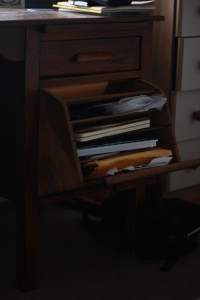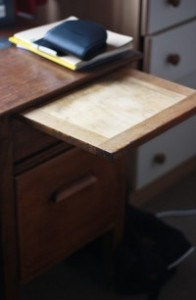“I have loved the ‘circular economy’ ever since I came across it about half a year ago, although the basic ideas behind it were not unusual to me.
The circular economy is about reducing the amount of waste and pollution we generate, by keeping precious resources in the economy and preserving their value. So instead of throwing things away, and wasting all the energy, nutrients and minerals that went into making them, the idea is to reuse things as much as possible; to extend the lifetime of our possessions by repairing them; and, when the time comes, recycling them so that they can be put back into the economy under a new guise.
The thought – and reality – of waste in modern industrial societies is something that troubles me for a number of reasons. Landfills sadden me; they are the manifestation of a consumer culture that is disconnected from the environment. We no longer know where things come from nor do we care where they end up once we have used them. This goes for food as much as objects; the sight of perfectly edible food lying in bins, still wrapped in pristine plastic packaging, is what initially got me into sustainability and caring for the environment.
I have long had a fascination for second-hand objects; I can spend hours sifting through the backrooms of antique stores, and my most-loved items of clothing are either hand-me-downs or charity shop finds. The circular economy therefore lends legitimacy to what I had always thought of as a quirky penchant for old things. It also makes perfect economic and environmental sense. But there’s more to it than money, or even the environment; this alternative economy is founded on different ways of living and consuming which are exciting and inspiring. Thinking outside the box of linear consumption – buy, use, chuck – can lead to innovation in everyday life.
This blog series will be about my own efforts to innovate and kick that old habit of consumerism. I have been inspired by the Circular Cambridge challenge, organised by Cambridge Carbon Footprint, and the posts will cover the six areas which participants are encouraged to engage with:
- Repair
- Rehome
- Relate
- Reuse
- Recycle
- Refuse
I have decided to start with ‘repair’ – or ‘revamp’, because I recently did a bit of DIY restoration which I was extremely pleased with, and wanted to share with the world. It has to be said that a lot of my circular economy projects and activities fall into more than one category, but this is part of the beauty of the circular economy: it often leads to multiple ‘wins’.
Back in August, while wandering down the back alleys of the Custard Factory in Birmingham, I came across a small antiques shop. There were some really beautiful chairs, from fabulous upholstered ones to these rickety wooden frames with woven seats, just like the ones in my grandparents’ house. I was in vintage furniture heaven, and started chatting with the owner, who, coincidentally, was auctioning off the whole shop to start a renewable energy business. I told him I was looking for a desk, and he showed me a few ‘real’ antiques – not quite the practical bit of wood I was looking for. And then I spotted a small, slightly worn out table which was being used by the owner himself. It would have been a sweet, albeit not exceptional desk, if it hadn’t been for the special features: the drawers. It features a pull-out extension for a wireless mouse (or convenient place to put your coffee, if you’re not likely to elbow it) and a multi-compartment filing drawer, something I had never seen before and was instantly smitten with.
I haven’t done much up-cycling of furniture beyond picture frames before, but my dad was keen to make it one of his little projects and advised me on sanding, staining and waxing. I’ll confess he did most of the sanding bit without me (on his own initiative), but I chose the varnish and joined in for one afternoon of manual labour.

Some shots of the unique features:
And the final product, sadly in a not very well lit spot for photos:
The number of craft projects I took on over the summer of 2015 is evidently a testimony to how bored I was at home – although I am grateful for the downtime which motivated me to get crafty. Another afternoon’s work produced this frame:
Instead of paying £18 for a professional mount at my local frame shop, I bought a simple frame from a used furniture place for £3, and used some thick white card as a backing.”
To find out more about Giulia’s experience, see her blog: https://giuliagoesgreen.wordpress.com/




